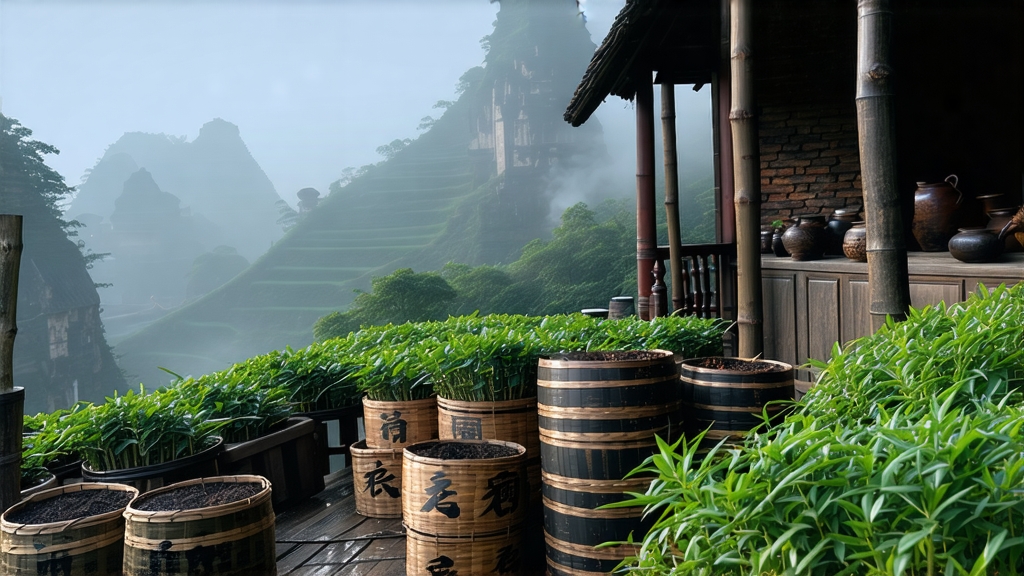
Tucked away in the humid, karst-pocked mountains of southern Guangxi, Liu Bao tea has spent four centuries quietly perfecting the art of transformation. While Pu-erh hoards the international spotlight, Liu Bao—literally “Six Forts,” named after the six stockades that once guarded the trade route—has remained the connoisseur’s whisper, a tea whose flavour carries the echo of horse caravans, river ferries, and the slow breathing of bamboo baskets. To drink Liu Bao is to taste history in motion: leaves that left the subtropical forests of China, travelled with coolies and merchants across the South China Sea, and returned decades later, mellowed by salt air and equatorial heat, to astonish the very farmers who first picked them.
Historical footprints
The earliest written record appears in the 1661 edition of the Cangwu County Annals, noting that “dark tea from Liu Bao is bartered for salt in Guangdong.” By the Qing dynasty the tea had become a tax commodity; imperial archives list 1,500 dan (90 tonnes) annually shipped through the Xun River to Guangzhou, then reloaded onto junks bound for British Malaya and the Straits Settlements. Overseas Chinese labourers valued Liu Bao for its ability to calm stomachs soured by ship rations and tropical humidity; tin-miners in Ipoh swore it prevented malaria, calling it “kopi hitam Cina.” In 1886 the tea fetched more silver than Xinhui tangerine peel on the Singapore waterfront, yet inside China it was merely “coolie tea,” wrapped in bamboo husks and strapped beneath horses’ bellies. The double life—revered abroad, overlooked at home—continues to shape Liu Bao’s mystique.
Micro-terroirs within one name
Guangxi’s Wuzhou municipality governs the original six fort districts, but today the appellation stretches across 24 townships. Purists single out three micro-zones:
- Yao Mountain: 600–800 m, granitic soils, morning fog; yields a bright orange liquor with orchid-betel top notes.
- Liudong Basin: red laterite rich in iron, warmer nights; tea here develops the famous “pine-smoke & longan” aroma.
- Heli Gorges: shale cliffs, drastic diurnal swing; leaves remain sappy, producing a creamy, soy-milk texture after aging.
Each mountain’s leaf chemistry diverges enough that experienced tasters can blind-identify provenance by the third infusion.
From green to dark: the craft of pile-fermentation
Unlike Pu-erh’s shai-qing (sun-kill-green) phase, Liu Bao undergoes wok-kill at 280 °C for eight minutes, locking in a deeper enzymatic baseline. While still hot, the leaves are rolled on rattan mats until the epidermis splits into fish-scale flakes, then piled 70 cm deep inside bamboo-lined chambers. A mist of mineral-rich spring water is sprayed every two hours; thermophilic bacteria—Bacillus subtilis, Aspergillus niger—raise the core temperature to 58 °C, caramelising leaf sugars into the signature “betel-nose” aroma. After 25–30 days the pile is broken, sun-dried, and steamed soft again for compression into 40 kg bamboo baskets called lang. A final six-month “dragon-boat” rest in riverside warehouses allows residual moisture to equilibrate; only then is the tea permitted to leave the county.
Time as co-blender
Liu Bao is perhaps the only tea whose flavour arc improves after being re-roasted every decade. Traditional Hong Kong tea merchants practise the “three-seven” rule: three years on the mainland, seven years in a humid subtropical loft where typhoons spike ambient moisture to 90 %. The cyclical swelling and contracting of leaf fibres hastens oxidation, producing camphor, sandalwood and dried jujube notes. A 1958 basket auctioned in Kuala Lumpur in 2018 brewed the colour of black cherry and tasted of molasses, pipe tobacco and the faintest whisper of star anise—proof that Liu Bao can rival vintage Burgundy for complexity.
How to brew: the gongfu of patience
Water: spring or filtered, 100